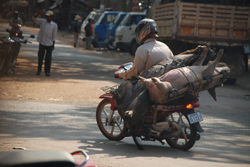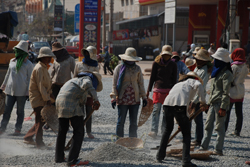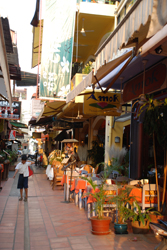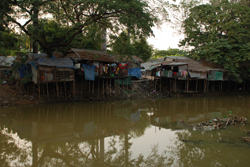Luxury Life in one of the Poorest Countries in Asia
29 January, 2009, 02:39 am in "Cambodia"
The slick new road into town was bordered with palatial luxury hotels with names containing words like “Royal” or “Empress”. Only a little while before, the only buildings we saw were simple wood huts on stilts with no glass windows or screens, just wooden shutters. These rose from marshy areas. During the rainy season they would rest on the surface of the lakes, ponds and rivers they bordered. I'm not sure what happens to the road.
The landscape was flat and stretched off into the distance, making the sky seem larger. Rice plants grew in paddies, poking out of a thin layer of water. White cattle grazed, drifting across the paddies like clouds.
People in wide hats and krama scarves to shield themselves from the sun, stood in muddy pools fishing using nets. This fit more with how I imagined Cambodia would be and, in truth, it is. Arriving in Siem Reap is like being suddenly transplanted onto another planet. The streets we walked down are full of stylish hotels, gourmet restaurants, spas, galleries, and chic boutiques. However, this is luxury everyone can afford... well... except the average Cambodian.
People in wide hats and krama scarves to shield themselves from the sun, stood in muddy pools fishing using nets. This fit more with how I imagined Cambodia would be and, in truth, it is. Arriving in Siem Reap is like being suddenly transplanted onto another planet. The streets we walked down are full of stylish hotels, gourmet restaurants, spas, galleries, and chic boutiques. However, this is luxury everyone can afford... well... except the average Cambodian.
Someone at some point presented a theory that you can tell what is the most important/powerful feature of a society by looking at the largest buildings. For example: first the largest buildings were for religion- zigurats in Sumer because the priests were most important. Then the kings gained power so castles and palaces were the largest. Then business took priority and the cities gained skyscrapers. Well, in Siem Reap, by this standard, the tourist is king and hotels are dwarfing the wats that had earlier claimed this position of priority. Ironically, it is Angkor Wat that has made this a tourist town.
However, it is amazing how this luxury world slips away once you are out of the center. Suddenly the buildings shrink back down to one story shops with thin wooden walls and traditional wooden stilt houses occupying spots next to the river. The pavement gives way to sandy roads and the wats re-claim their position of dominance in society.
However, it is amazing how this luxury world slips away once you are out of the center. Suddenly the buildings shrink back down to one story shops with thin wooden walls and traditional wooden stilt houses occupying spots next to the river. The pavement gives way to sandy roads and the wats re-claim their position of dominance in society.
The hotels are still encroaching and across from the stilt houses, new multistory hotels are springing up. The contrast of the center and the area outside is startling. I'm really curious how tourism is helping and/or harming the society. It looks like it is bringing a lot of money and providing a lot of jobs and new businesses. But are many of the businesses owned by foreigners? It is a very sophisticated tourist scene with lots of emphasis on fine art, gourmet food and spas. How did it get to be this way? Is it getting out of control? There are also a lot of NGOs that seem centered here.
Comments
- Comments
Powered by My Blog 1.69. Copyright 2003-2006 FuzzyMonkey.net.
Created by the scripting wizards at FuzzyMonkey.net..
(Code modified by Rowshan Dowlatabadi)
Created by the scripting wizards at FuzzyMonkey.net..
(Code modified by Rowshan Dowlatabadi)





